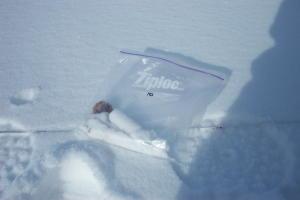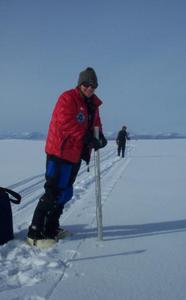26 March, 2002
I think everybody needs to realize the extremes that I and the team go to
every evening for journals to be written and posted. I am sitting in the
small but cozy, heated RV sled. It’s close to 10pm and we have been
working out in the cold the entire day. Matthew is sitting in the sled
configuring the data that was taken during the day. I could easily let my
mind be absorbed in teaching students about science and forget where I am.
However, all I have to do is open up the sled door to retrieve my dinner
and notice the bright Arctic moon. The moon and the sun are amazing every
day. They capture the Arctic beauty. They are the beauty of the Arctic.
The moon along with sun have rainbow halos that form around them. The
halos appear in an arc shape. Sometimes the halos completely encircle the
moon at night and the sun during the day.. It’s captivating and
fascinating. The halos form due to the light being reflected off of the
ice crystals in the sky. This only happens in cold places such as the
Arctic…..Arctic magic.
SWEEEEEEEE’s!!!!! Otherwise known as running the sweeet tube!!!! Or we can
rap SWE, you know me…. Hey… hey….! Come on everybody join in to the Snow
science rap!!!!
No, Mrs. Cheuvront has not completely lost her mind. The Arctic can be
very mind enchanting and the snow can be very blinding as it reflects the
sun but science and much hard work takes place. SWE stands for snow water
equivalence. It is one of many of the measurements that we are taking
along the traverse. Taking the SWE’s requires taking a cylindrical, metal
tube and pushing it into the snow. You must push hard on the tube so it
completely goes into the ground and pulls out a vegetation plug. This
vegetation plug ensures that all of the snow from that core was retrieved.
The snow sample taken from the tube is then put into a numbered Ziploc
bag. The snow depth is recorded at the spot that the snow core was taken.
The mass of the snow in the bags are then taken using an electronic balance
(run off batteries). The SWE’s samples are taken along a 100 meter line.
We take a measuring tape and run it across the snow. Two SWE measurements
are taken every 25 meters along the line.
There will be more SWEEEEE’s calculations and the importance of SWEEEEE’s
over the next couple of days.
SO, WHERE IS MRS. CHEUVRONT????? LET”S PLOT!!!!
Actually on March 25, we finally left Council and camped at:
65.10813 degrees North
162.84192 degrees West
We camped here after a day of packing. We were also able to make a short
visit over to White Mountain. It was wonderful to see the precious
students at White Mountain. Special thanks to the teachers Cheryl and
Linda for all of their hard work! We hope you still follow SnowSTAR 2002.
and student Crystal needs to keep on smiling her pretty smile!!!!!!!
So, March 26, we made two full measurement sites in the forest and the
tundra. We are camping at the base of the Darby mountains where the snow
is scarce due to the rain/snow shadow effect of the mountains. The less
snow brings out the caribou. We spotted caribou today.
65.03197 North
163.31438 West
The weather has been warm!! We have been lucky. The highs during the day
are in the 20’s and at nights it reaches 0. I will begin posting regular
temperatures soon so you can make a line graph of the temperatures.

Glen massing the snow samples on the balance.

The SWE snow is stored in a numbered ziploc bag. The depth of the snow is recorded where the plug was taken.

Inside the heated sled working on journals and data processing. No, this is not a space module! We are not on the moon but in the Arctic!

Using the SWE tube to get the snow plug! Fun!
Contact the TEA in the field at
.
If you cannot connect through your browser, copy the
TEA's e-mail address in the "To:" line of
your favorite e-mail package.
|
